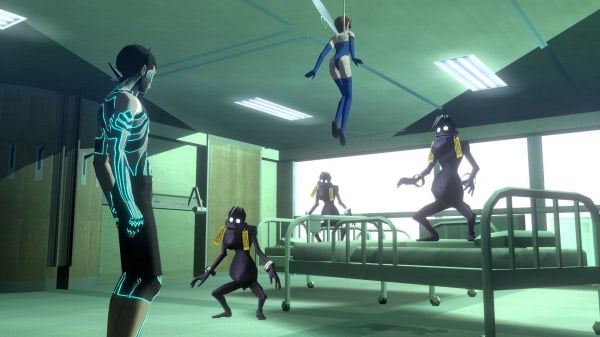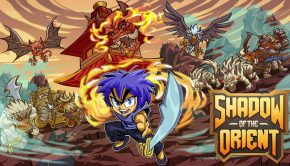Shin Megami Tensei III Nocturne HD Remaster Switch Review
Summary: An underwhelming port of a cult classic.
3.75
Disclaimer: I am a Persona fan, and have never played a Shin Megami Tensei game. Upon Persona 5’s release, I fell in love with the story, characters, battle system, and the presentation’s dramatic flair. Since then I’ve enjoyed a few other Persona mainline and spin off games, but have been itching to get my hands on a Shin Megami Tensei title, the series Persona is based off. With Shin Megami Tensei V arriving on Switch later this year, Nintendo decided to port the cult classic Shin Megami Tensei III Nocturne to acclimate fans to the long running series before the fifth mainline entry arrives on a home console for the first time in eighteen years. Though Nocturne’s core is strong, the port itself leaves much to be desired, and might not be the gateway into SMT Nintendo desired.
Nocturne paints a sobering tale of a post apocalyptic world overrun by demons with only a handful of human survivors. The player assumes control of a once high schooler turned demi-fiend who has the power to rebuild a new world to his liking. Along the way, many characters will attempt to sway the player to mold the world as they see fit, which can lead to intriguing philosophical questions on how to properly shape society. /cdn.vox-cdn.com/uploads/chorus_image/image/68995893/image5.0.png)
Though the plot is fascinating, it serves more as ambience for a dark and turbulent world, with Nocturne’s focus being more on enemy encounters and dungeon crawling.
In turn based battles, the player chooses from a plethora of options ranging from physical or magical attacks, to stat buffs and debuffs. In order to thrive the player must understand enemy weaknesses and target them with the corresponding magical attacks. The challenge is conserving MP as the demi-fiend treks through dungeons on his way to the inevitable boss fight at the end. Though nearly twenty years old, the combat system still feels great to play and experiment with, and the gameplay loop of leveling up and learning new abilities is quite engaging. The demi-fiend can also consume material known as magatama to manipulate his stats and elemental affinity, allowing the player to customize the character to their desired play style.
Adding another level of customization is the demon recruiting mechanic. After clearing away all but one demon, the demi-fiend may attempt to negotiate with the foe to join the team. This usually involves bribing a demon with cash, items, or responding to a philosophical quandary. Once committing to the player, the demon will join the party and up to four will fight alongside the demi-fiend in combat. This system is incredibly deep, especially since you can fuse your acquired demons into stronger ones in endless configurations. With nearly 200 demons to acquire and fight with, the possibilities are endless.
The SMT series is known for its difficulty, and Noturne is certainly challenging, even on normal mode. Though I knew the basics of the system from my experience with Persona, battles prove to be punishing unless thoroughly prepared. The added Merciful difficulty is a nice addition for those looking to simply enjoy the plot, but taking out even the most intimidating enemies in five to six attacks removes much of Notcurne’s identity.
Dungeons are endless winding corridors usually involving wondering aimlessly until stumbling upon the correct doorway to progress. Though there are some engaging puzzles sprinkled in, progression feels more like trial and error rather than intuitive exploration. And the combination of each dungeon passageway being uniform in aesthetic and a lackluster compass, it is easy to get discombobulated.
Making dungeons increasingly frustrating are the slightly outdated random encounters. This certainly makes grinding accessible, but when I’ve been in a dungeon for hours and just want to find the way out, the last thing I want to hear is the battle theme again. Not only that but there really isn’t a break from combat; even the hub areas filled with friendly demons are not safe from enemy encounters. I understand this was part of the technology restrictions in 2003, but it now feels a bit antiquated. 
Though Nocturne is still a strong game, even by today’s standards, Atlus’s port job leaves much to be desired. Aside from added voice acting (which is quite strong), smoothed out graphics, the merciful difficulty mode, and all available DLC (yes, Dante from Devil May Cry is in this game and its weird), there are no improvements to the core experience. I’ve been impressed with many recent remasters for fixing issues related to bygone console limitations, but Nocturne does not fall under that category. I would have loved to see an updated map, enemies in the over world, or an enemy information screen for foes already analyzed. And though a solid soundtrack, it is unacceptable in 2021 for the music to sound as muffled and compressed as it does, especially with a remastered version already in existence.
For lack of a better term, this Nocturne port is a “hardcore” game. The gameplay is dense, repetitive, may be difficult for newcomers to engage in, but ultimately rewarding if time is dedicated to it. This is a smoothed out port of a fantastic PS2 game, but comes with all the troupes and technical limitation of days gone with limited effort to bring it into the modern era. If you are a Persona fan or a newer RPG gamer looking for an intro into the SMT series, you might want to wait until Shin Megami Tensei V. But if you want a dark, punishing, intricate experience and don’t mind the rough edges, pick this one up.








